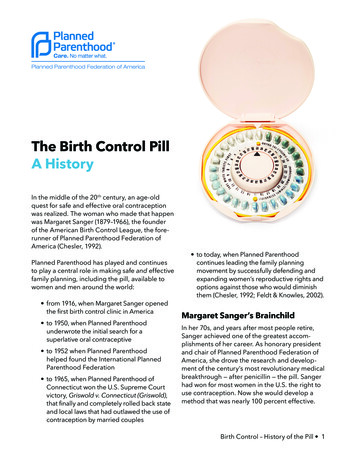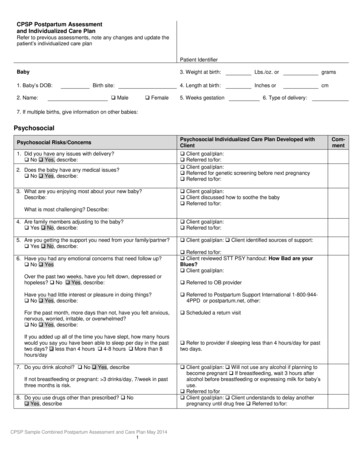
Transcription
The Birth Control PillA HistoryIn the middle of the 20th century, an age-oldquest for safe and effective oral contraceptionwas realized. The woman who made that happenwas Margaret Sanger (1879–1966), the founderof the American Birth Control League, the forerunner of Planned Parenthood Federation ofAmerica (Chesler, 1992).Planned Parenthood has played and continuesto play a central role in making safe and effectivefamily planning, including the pill, available towomen and men around the world: from 1916, when Margaret Sanger openedthe first birth control clinic in America to 1950, when Planned Parenthoodunderwrote the initial search for asuperlative oral contraceptive to 1952 when Planned Parenthoodhelped found the International PlannedParenthood Federation to 1965, when Planned Parenthood ofConnecticut won the U.S. Supreme Courtvictory, Griswold v. Connecticut (Griswold),that finally and completely rolled back stateand local laws that had outlawed the use ofcontraception by married couples to today, when Planned Parenthoodcontinues leading the family planningmovement by successfully defending andexpanding women’s reproductive rights andoptions against those who would diminishthem (Chesler, 1992; Feldt & Knowles, 2002).Margaret Sanger’s BrainchildIn her 70s, and years after most people retire,Sanger achieved one of the greatest accomplishments of her career. As honorary presidentand chair of Planned Parenthood Federation ofAmerica, she drove the research and development of the century’s most revolutionary medicalbreakthrough — after penicillin — the pill. Sangerhad won for most women in the U.S. the right touse contraception. Now she would develop amethod that was nearly 100 percent effective.Birth Control – History of the Pill 1
Katharine Dexter McCormick(1875–1967)In the 1940s and 1950s, Sanger closely followedscientific research on birth control and personally funded some of it. Planned ParenthoodFederation of America also made support fornew birth control technology a major focus of itsadvocacy efforts. The turning point came whenSanger’s longtime friend — Katharine DexterMcCormick — threw her financial support behindresearch to produce an oral contraceptive(Chesler, 1992).McCormick was Sanger’s closest collaboratorduring her career. She was an avid crusaderfor women’s rights, had been a leader in thesuffrage movement (Fields, 2003), had helpedestablish the League of Women Voters (Fields,2003), and was the second woman to graduatefrom the Massachusetts Institute of Technology(Fields, 2003), where she studied biology.McCormick was also heir to the InternationalHarvester fortune. In 1950, following the deathof her husband, Stanley, McCormick wrote toSanger to ask how she could use her inheritanceto contribute to contraceptive research (Chesler,1992). This helped Sanger shift her search for anoral contraceptive into high gear during 1951(Chesler, 1992).In 1953, Sanger took McCormick on a personalvisit to the Worcester Foundation for Experimental Biology in Massachusetts, whereresearch scientists Gregory Pincus and MinChueh Chang were conducting experiments thatSanger considered promising — at her behest,they were trying to produce an oral contraceptive based on synthetic progesterone.Inspired by the visit, McCormick — also in her 70s— used her scientific knowledge to watch overthe research process. As Gregory Pincus said,“she knew the field” (Fields, 2003). And she usedher inheritance to supply the financial backingthat was so desperately needed.2 Birth Control – History of the PillMcCormick first pledged 10,000 toward theresearch. Soon after, she began contributing 150,000 to 180,000 a year, funneling a portionof the money through Planned Parenthood’sresearch grant program. (Planned Parenthoodhad supported Pincus’ early studies on mammalian eggs that led him to the work he would doon the development of the pill.) The total ofMcCormick’s gifts to the research was 2 million,which would be more than 18 million in today’sdollars (Asbell, 1995; Chesler, 1992; Grimes,2000).All in all, McCormick donated the lion’s share ofthe financial resources needed for the researchthat enabled the fulfillment of the dream sheshared with Sanger — making birth control safe,dependable, affordable, and controlled bywomen (Chesler, 1992).The efforts to develop an oral contraceptive would have been for naught, however, if ithadn’t been for the medical folk traditions of thedescendants of the Aztecs. The basic researchfor the pill became possible when RussellMarker discovered that generations of Mexicanwomen had been eating a certain wild yam —the Barbasco root, also called cabeza de negro— for contraception (Asbell, 1995). It was fromthese yams that Marker was able to extract theprogestin that Gregory Pincus combined withestrogen to formulate the first birth control pill(Grimes, 2000).Dr. John Rock (1890–1984)McCormick also funded the first clinical trialsof the pill, which were conducted by Dr. JohnRock, an eminent gynecologist and a RomanCatholic, with patients in his private practice.Rock, who came to be regarded as a co-developer of the pill, worked with Planned Parenthoodstaff on a closely reasoned book, The Time HasCome: A Catholic Doctor’s Proposals to End theBattle over Birth Control, in which he argued —
unsuccessfully — that the Catholic church shouldaccept the oral contraceptive as a natural extension of the “rhythm method” (Chesler, 1992).But distributing contraceptives or informationabout contraceptives was illegal in Massachusetts, so Rock had to find another venue forwider clinical trials, or pay a 1,000 fine eachtime he or one of his staff gave a contraceptiveor contraceptive advice to one of the women inthe trial (or spend five years in prison) (Marks,2001). Holding yearlong, large-scale trials inother states where contraception was legal wasalso challenging because, after World War II,American women of reproductive age becamehighly mobile. Keeping a trial cohort together forup to three years was absolutely necessary, soless mobile populations of women were sought(Marks, 2001).After also considering Japan, Hawaii, India,Mexico, and New York, Rock and his colleaguessettled on Puerto Rico as the best place to holdthe trials (Marks, 2001). From the very beginning,this decision opened them to fallacious charges ofracism (Tone, 2001; Marsh & Ronner, 2008). In fact,they settled on Puerto Rico for several reasons: It had no laws against contraception. It had a well-established network of birthcontrol clinics. It was close enough to the U.S. to allow easyvisits from the research team. Many medical practitioners on the islandhad been trained in the U.S., and Pincusknew and trusted them. Many of the women were semi-literate orilliterate, which allowed the researchersto test whether or not the pill couldalso be used by women around theworld, regardless of their educationalaccomplishments. Puerto Rico was an island with a relativelystable population that could be followed forthe full length of the trial. Many Puerto Rican women were eager tohave more effective methods of reversiblebirth control than those that were availableto them (Marks, 2001; Tone, 2001; Marsh &Ronner, 2008).Participants had to meet four criteria: They hadto be in good health. They had to be under 40.They had to have had at least two children — toprove they were fertile. And they had to agree tohave a child if they became pregnant during thestudy (Tone, 2001).Critiques of the Clinical Trials for thePillCritics of the early pill trials point out retrospectively that the women involved did not giveinformed consent with their signatures. In thelate ‘50s and early ‘60s, however, having subjectssign informed consent documents to participatein clinical trials was not a common procedure.In the 1980s, Dr. Luigi Mastroianni, one of JohnRock’s colleagues, recalled thatThe concept of informed consent that is sotalked about now, and is a legal requirementof any research project involving humanvolunteers, didn’t exist then. But Rock practiced it [informed consent] before it wasever defined. There were always long andlarge discussions of the risk factors. It didn’tmatter that Rock had no formal guidelines,he set his own, and they were high standardsindeed (Marks, 2001).Retrospective critics have been concerned thatthe clinical trials did not meet today’s standards.But the pill was thoroughly tested by the standards of the day. Today, the numbers of womenin the trial and the amount of time they wereobserved would not be acceptable. Before theFood and Drug Administration (FDA) approvedthe pill in 1960, 221 women in Puerto Rico hadtaken it in two clinical trials. More than 130 ofthem had used it for between one and threeyears. Thousands more in Australia, Britain,Birth Control – History of the Pill 3
Ceylon, Chicago, Haiti, Hong Kong, Japan, LosAngeles, Mexico City, Seattle, and Tennesseewere involved in clinical trials of various formulations of the pill. Another 500,000 women hadused the first brand — Enovid — for up to threeyears for menstrual regulation. But in the end,Searle submitted reports on only 897 women inits application for FDA approval (Asbell, 1995;Marks, 2001; Marsh & Ronner, 2008).By today’s standards, these were small clinicaltrials, but small trials were not unusual at thattime. For example, the 1960 approval of Libriumto treat anxiety was based on the experience ofonly 570 psychiatric patients, although 593 otherpatients used it for a wide range of conditionsthat included ezcema, “frigidity,” heroin addiction, and spastic colon (Junod & Marks, 2002;History of Psychology, 2010).A Smashing SuccessThe clinical trials began in April 1956 (Marsh& Ronner, 2008). That same year, the journalScience announced their ongoing success. In1957, the FDA approved the use of the pill toregulate menstruation. By 1959, 500,000 womenwere ostensibly using it to keep their periodsregular, while enjoying its contraceptive “sideeffects.” They knew the medication had contraceptive effects because every package had awarning about its “contraceptive activity” on thelabel (Asbell, 1995).On June 23, 1960, the FDA approved the saleof Enovid for use as an oral contraceptive. It wasmanufactured by G.D. Searle and Company, afirm that had also supported Gregory Pincus’research for many years (Chesler, 1992; FDA,2000, Grimes, 2000; Lange, 2007).By 1965, one out of every four married womenin America under 45 had used the pill. By 1967,nearly 13 million women in the world wereusing it. And by 1984 that number would reach50–80 million (Asbell, 1995). Today more than4 Birth Control – History of the Pill100 million women use the pill (Christin-Maitre,2013).Sanger’s tenacious efforts, even as her healthdeclined, brought about the advent of safe andeffective oral contraception and changed thehuman sexual landscape forever. It reduced therisk of unintended pregnancy in the context ofthe sexual revolution of the ‘60s and establishedfamily planning as the cultural norm for the U.S.and in many other countries of the world.The First PillThe first pill was effective and simple to use. Itextended to millions of women an unheard-ofcontrol over reproduction, for the first time allowingthem to truly separate vaginal intercourse fromprocreation (Bullough & Bullough, 1990). But it wasfar from perfect.The first brand, Enovid, had a lot more hormonesin it than needed to prevent pregnancy. Itcontained 10,000 micrograms of progestin and150 micrograms of estrogen. In comparison,today’s lower-dose pills are more likely to contain50–150 micrograms of progestin and 20–50micrograms of estrogen (Knowles & Ringle,1998; Tone, 2001).Side Effects and Adverse EventsThe original high doses increased the likelihood and severity of side-effects and the potential for rare, but very serious risks, such as heartattack and stroke. Unfortunately, it took scientists more than a decade to recognize the risksand side effects and to learn that much lowerdoses were just as effective as the higher dosesat preventing pregnancy.Side effects had been very apparent in the firstclinical trials. Dr. Edris Rice-Wray, who was incharge of the first trials in Puerto Rico, reportedearly on that 17 percent of the women in the firstcohort had significantly unpleasant side effects,
including dizziness and nausea, as well as headaches and vomiting. In fact, 25 of them withdrewfrom the trials because the medication madethem so uncomfortable.In her first report, Rice-Wray concluded thatalthough the pill provided nearly 100 percentprotection against unintended pregnancy, “itcauses too many side reactions to be acceptablegenerally” (Asbell, 1995; Marsh & Ronner, 2008).Gregory Pincus, the head of the research team,was delighted with Rice-Wray’s report that thepill was so effective at preventing pregnancy bysuppressing ovulation. But he ignored Dr. RiceWray’s concerns about side effects. Perhapsbecause Pincus was a biologist, not a physician, he had little clinical empathy for what heregarded as hypochondria among the women inthe trials (Marsh & Ronner, 2008).Not only did many women in the first clinicaltrials in Puerto Rico have distressing side effects,one woman died of congestive heart failure,and another developed pulmonary tuberculosis(Marks, 2001, 107). During medical checkups andin reports on the women in the trials, however,researchers were so focused on watching forcarcinogenic effects and damage to the cervix,endometrium, liver, and ovaries that it did notoccur to them that these adverse events wererelated to the pill (Marks, 2001; Marsh & Ronner,2008).Early critics of the pill were right that a lot couldbe done to improve it. Among the millions ofwomen using the pill worldwide, there weredisturbing reports of nausea, breast tenderness,water retention, and weight gain.Much more alarming was G.D. Searle’s 1961report to the FDA of 132 incidents of thrombosis (blood clots) and embolism (clots movingthrough and blocking a blood vessel) amongwomen using the pill. But the FDA held thateven if the pill caused these adverse events, therate of them — 1.3 out of 100,000 users — wasmuch lower than the rate of women who woulddie from pregnancy complications —36.9 out of100,000 pregnant women (Asbell, 1995; DHS,N.D.).The governments of Norway and the SovietUnion were not reassured, and they banned thesale of the pill in 1962 (Asbell, 1995).Barbara Seaman, Gaylord Nelson,and Hugh DavisAmong the most vocal, and certainly most effective, critics of the pill in the U.S., was BarbaraSeaman, who published The Doctor’s CaseAgainst the Pill in 1969. Seaman gave a sensationalized account of hundreds of women whosuffered side effects and adverse reactions thatshe and many others associated with the pill. Shealso attacked the American College of Obstetricians and Gynecologists and Planned Parenthood Federation of America for providing thepill, which she claimed was dangerous for allwomen.Medical science would prove Seaman rightabout some of the adverse events she claimedwere associated with the pill (e.g., blood clotsand strokes), and it would prove her very wrongabout others (e.g., cancer, harmful geneticeffects, and sterility) (Seaman, 1969; Tone, 2001).Seaman’s book was important because itprompted Senator Gaylord Nelson (D-WI) tohold hearings on whether the pill was dangerousfor the human body and whether or not womenwho used the pill had enough informationabout possible risks and side effects to makean informed decision to use it (Lehmann-Haupt,1970; Tone, 2001).While many who questioned the use of thepill were entirely motivated by an interest inwomen’s health, some were not. Hugh Davis, forexample, was one of the few gynecologists whospoke at Senator Nelson’s hearings. He was, infact, Nelson’s lead speaker, and he had a financial stake in the development and success of theBirth Control – History of the Pill 5
IUD. He was also one of the important medicalauthorities who gave credibility to Seaman’sattack on the pill in her book.Davis argued in Seaman’s book and testified atthe Nelson hearings that women would be saferusing a new IUD instead of the pill. During histestimony, Davis covered up the fact that he hada financial interest in promoting this new IUD— the Dalkon Shield, which later proved to be ahealth catastrophe for thousands of women andthe cause of bankruptcy, in 1985, for its manufacturer, A.H. Robins (Asbell, 1995; Tone, 2001;Marsh & Ronner, 2008).The Package InsertNelson’s hearings on the safety of the pill ranfrom January 14 through March 1970. Feministsof the day demonstrated against them becauseno women were asked to speak about theirexperience with the pill. But the hearings didcontribute to the FDA’s eventual decision that pillpackaging must contain an insert with information about possible risks and side effects.Hundreds of women had written letters to theFDA during the Nelson hearings to demand thatmanufacturers be compelled to give them information about the possible side effects of themedication they were taking. And it was duringthe Nelson hearings that the FDA announcedthat it would compose information on thepossible side effects of the pill for a packageinsert that would be included with everypackage of pills.But the American Medical Association (AMA)opposed the use of a package insert on thegrounds that it would undermine a doctor’sauthority with “his” patients.The FDA backed off, but did require doctors togive the information to women whenever theyprescribed the pill. Between 1970 and 1975,however, doctors distributed only four million6 Birth Control – History of the Pillcopies of the information to the 10 millionwomen for whom they prescribed the pill everyyear. It wasn’t until 1978 that the FDA requiredthat the information be inserted into the pillpackages — and it wasn’t until 1980 that the FDArequired that the package insert be intelligible tothe average reader (Marks, 2001; Tone, 2001).It was during women’s struggle for informationabout the benefits and risks of using the pill,which lasted for two decades during the ‘60sand ‘70s, that Planned Parenthood earned agood deal of the respect it enjoys today. Duringthe information wars between Congress,the FDA, the AMA, and the women, PlannedParenthood filled the gap with its own clientinformation publications about the pill anddeveloped its own medical standards andguidelines to ensure that all women whocame to Planned Parenthood for the pillwould receive balanced information about itsrisks and benefits (PPFA, 1976).Despite the controversies around the pill, in1970, President Richard M. Nixon signed into lawTitle X of the Public Health Services Act, whichprovided federal support and funding for familyplanning services. Working with Title X grants,Planned Parenthood was able to provide accessto the pill to hundreds of thousands of low-income women across the United States.A year later, PPFA established it own international program, which was funded largely bythe U.S. Agency for International Development(USAID). With USAID grants, Planned Parenthood was able to bring effective and safemodern methods of birth control — including thepill — to millions of women and men around theworld (Feldt and Knowles, 2002).The cultural ramifications of the widespreaduse of the pill are nearly impossible to measure.Most women in the ‘70s believed the benefitsof the pill far outweighed the risks. They agreedwith Loretta Lynn that the pill was a key to their
liberation. As she sang in her hit song of 1975,“The Pill” All these years I’ve stayed at homeWhile you had all your funAnd every year that’s gone byAnother baby’s comeThere’s a-gonna be some changes madeRight here on nursery hillYou’ve set this chicken your last time‘Cause now I’ve got the pill This incubator is overusedBecause you’ve kept it filledThe feelin’ good comes easy nowSince I’ve got the pillIt’s gettin’ dark it’s roosting timeTonight’s too good to be realOh but daddy don’t you worry none‘Cause mama’s got the pillOh daddy don’t you worry none‘Cause mama’s got the pill (McHan, 1973)Mechanism of ActionToday’s PillNon-Contraceptive Uses of the PillIn 1993, The Economist named the birth controlpill one of the Seven Wonders of the ModernWorld because “When the history of the 20thcentury is written, it may be seen as the first[time] when men and women were truly partners.Wonderful things can come in small packets”(May, 2010).The combined hormone contraceptive pill isthe first line of therapy for women who preferto have no periods and for otherwise healthywomen who haveThe pill is still America’s most popular reversiblemethod of contraception. Sixteen percent of allwomen between 15 and 44 use the pill (Danielset al., 2014). That comes to nearly 30 percent ofall women who use birth control (GuttmacherInstitute, 2014).EffectivenessIf the pill is used as directed, only three out of1,000 women will become pregnant in the firstyear of use. About nine out of 100 less consistentusers will become pregnant in the first year ofuse (Nelson & Cwiak, 2011).The pill works by inhibiting ovulation and bythickening cervical mucus, which prevents spermfrom entering the fallopian tubes where fertilization takes place. The theory that the pill interferes with implantation has not been proved(Nelson & Cwiak, 2011).Possible Side Effects and RisksPossible side effects that usually last only thefirst three months include breast tenderness,headaches, irregular bleeding, and nausea.Some women also experience changes in theirsex drive (Nelson & Cwiak, 2011).Rare but serious health risks include blood clots,heart attack, stroke, increased blood pressure,liver tumors, gallstones, and jaundice — womenwho are over 35 and smoke are at a greater riskfor some of these problems (Nelson & Cwiak,2011). absence of menses due to hyper athleticismor eating disorders anemia due to heavy menses certain kinds of recurring ovarian cysts emotional challenges that cause fear ofmenstrual bleeding family histories of cancer of the ovaries heavy, infrequent, irregular, or painfulmenses non-menstrual uterine bleeding personal risks for cancer of theendometrium premenstrual dysphoric disorderBirth Control – History of the Pill 7
symptoms of premenstrual syndrome(Nelson & Cwiak, 2011)Non-Contraceptive Benefits of thePillUse of combined hormone oral contraceptiveshas many non-contraceptive benefits. Theseadvantages include reduced symptoms of endometriosis decreased chances of ectopic pregnancy less menstrual flow and cramping quick return of ability to become pregnantwhen use is stopped reduced acne reduced bone thinning reduced iron deficiency anemia related tomenstruation reduced premenstrual symptoms reduced risk of ovarian and endometrialcancers shorter and more regular periods (Nelson & Cwiak, 2011))SafetyIn early 2010, a study of 46,112 women in the U.K.who were observed for up to 39 years showedthat using the pill did not, overall, increase awoman’s risk of mortality. It showed, in fact, thatpill use among these women may have increasedlongevity (Hannaford et al., 2010).Impact of the PillIt was just five years after the pill was approvedfor use as a contraceptive in 1960 that birthcontrol became legal nationwide in the U.S.That is why the impact of the pill on the healthand lives of women and their families will be8 Birth Control – History of the Pillforever intertwined with the 1965 U.S. SupremeCourt decision in Griswold v. Connecticut, whichprotected the constitutional right of marriedcouples in this country to use birth control (Griswold). (It wasn’t until 1972, in its decision in Eisenstadt v. Baird, that the Supreme Court found thatunmarried people had the same constitutionalright to obtain contraceptives as married people[Eisenstadt]).In the five decades since these events, profoundand beneficial social changes occurred, in largepart because of women’s relatively new freedomto effectively control their fertility — maternal andinfant health have improved dramatically, theinfant death rate has plummeted, and womenhave been able to fulfill increasingly diverseeducational, political, professional, and socialaspirations.Planning and Spacing PregnanciesThe ability to plan and space pregnancies hascontributed to improved maternal, infant, andfamily health: In 1965, there were 31.6 maternal deaths per100,000 live births (NCHS, 1967). By 2007,the rate had been reduced by 60 percent, to12.7 maternal deaths per 100,000 live births(Xu et al., 2010). In 1965, 24.7 infants under one year of agedied per 1,000 live births (NCHS, 1967).Preliminary data for 2011 shows that thisfigure had declined to 6.05 infant deathsper 1,000 live births, a 76 percent decrease(MacDorman et al., 2013).Since 1965, there has been a dramatic declinein unwanted births — the result of pregnanciesthat women wanted neither at the time they wereconceived nor at any future time. This decline isparticularly welcome because unwanted birthsare associated with delayed access to prenatalcare and increased child abuse and neglect
(Piccinino, 1994; Committee on UnintendedPregnancy, 1995). In 1961–1965, 20 percent of births to marriedwomen in the U.S. were unwanted. (Mosher,1988). By 2006-2010, only 8.9 percent ofbirths to married women in the U.S. wereunwanted, a 56 percent reduction (Mosheret al., 2012).Mistimed births — those that happened soonerthan the woman wanted them — have alsodeclined markedly. In 1961–1965, 45 percent of births to marriedAmerican women were mistimed; (Mosher,1988); in 2006-2010, only 16.4 percent ofbirths to married women in the U.S. weremistimed, a reduction of 64 percent (Mosheret al., 2012).Education and EmploymentBy enabling women to control their fertility,access to contraception broadens their ability tomake other choices about their lives, includingthose related to education and employment.Since 1965, the number of women in the U.S.labor force more than tripled, and women’sincome now constitutes a growing proportion offamily income: In 1965, 26.2 million women participated inthe U.S. labor force; by 2014, the numberhad risen to 73 million (U.S. Census Bureau,2009; BLS, 2015a). The labor force participation rate of marriedwomen nearly doubled between 1960and 2013 — from 31.9 to 58.9 percent (U.S.Census Bureau, 2009; BLS, 2014). By 2012, 29 percent of women in dualincome families earned more than theirhusbands (BLS, 2014). In 1960, women represented three percentof the lawyer population. By 2014, womenrepresented 33 percent of all lawyers (BLS,2015b; Epstein, 1981). Between 1960 and 2013 the percentage ofwomen who had completed four or moreyears of college increased sixfold — from 5.8percent to 37 percent (U.S. Department ofEducation, 1993; Kena et al., 2014). In 1960, only 10 percent of all doctoratedegrees were awarded to women. Today,women are in parity with men — morethan half (51.4 percent) of doctorateswere awarded to women in 2012–2013(U.S. Department of Education, 1993; U.S.Department of Education, 2013).Publicly Funded ProgramsPublicly funded contraception programs haveincreased the ability of lower-income women toexercise the right to control their fertility.Family planning services available throughMedicaid and Title X of the U.S. Public HealthService Act help women prevent 2.2 millionunintended pregnancies each year. Withoutthese family planning services, the number ofunintended pregnancies and abortions wouldbe nearly two-thirds higher than it is (Frost et al.,2013).Worldwide ImpactWomen and men no longer need to abstainfrom sex for fear of having more children thanthey can afford or in terror of endangering awoman’s health with a high-risk pregnancy.In 1965, 35 percent of married women in theU.S. used a safe and effective method of familyplanning. Only one out of 10 women in thedeveloping world did so. Today approximately56 percent of couples worldwide rely on modernmethods of birth control to maintain the healthBirth Control – History of the Pill 9
and well-being of their families (PRB, 2014; Ryder& Westoff, 1971).As more and more women are able to plan theirfamilies with modern methods of contraception— the IUD and methods such as the implant andthe shot, which derive from the research thatdeveloped the pill — the number of pregnanciesper woman has decreased worldwide. Thisdecrease has been identified as one of the keyfactors associated with recently reported andsignificant reduction in the rate of maternalmortality around the globe (Hogan et al., 2010).As former U.S. Secretary of State Hillary RodhamClinton pointed out during the G8 Conferencein Gatineau, Quebec, “You cannot have maternalhealth without reproductive health, and reproductive health includes contraception and familyplanning and access to legal, safe abortions”(Campion-Smith, 2010).An Age-Old Need for Birth ControlHaving a baby is the least frequent motivatorfor most people to have sex (Hill, 1997). Thisseems to have been true for all people at alltimes throughout history. Contraceptives havebeen used in one form or another for thousandsof years — throughout human history and evenprehistory. In fact, family planning has alwaysbeen widely practiced, even in societies dominated by social, political, or religious codes thatrequired people to “be fruitful and multiply” —from the era of Pericles in ancient Athens to thatof Pope Francis, today (Himes, 1963; Pomeroy,1975; Blundell, 1995; Wills, 2000).Of course the methods used before the 20thcentury were not always as safe or effective as those available today. Centuries ago,for example, Chinese women drank lead andmercury to control fertility, which often resultedin sterility or death (Skuy, 1995). During theMiddle Ages in Europe, magicians advisedwomen to wear the testicles of a weasel on their10 Birth Control – History of the Pillthighs or hang its amputated foot around theirnecks (Lieberman, 1973). Other birth controlamulets of the time included wreaths of herbs,desiccated cat li
Participants had to meet four criteria: They had to be in good health. They had to be under 40. They had to have had at least two children — to prove they were fertile. And they had to agree to have a child if they became pregnant during the study (Tone, 2001). Critiques of the Clinical Trials for the Pill










